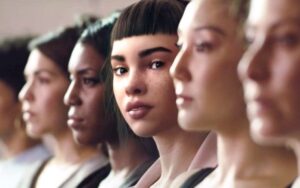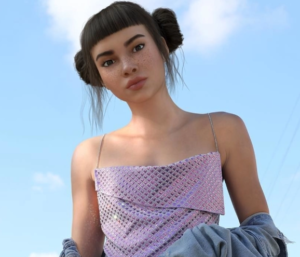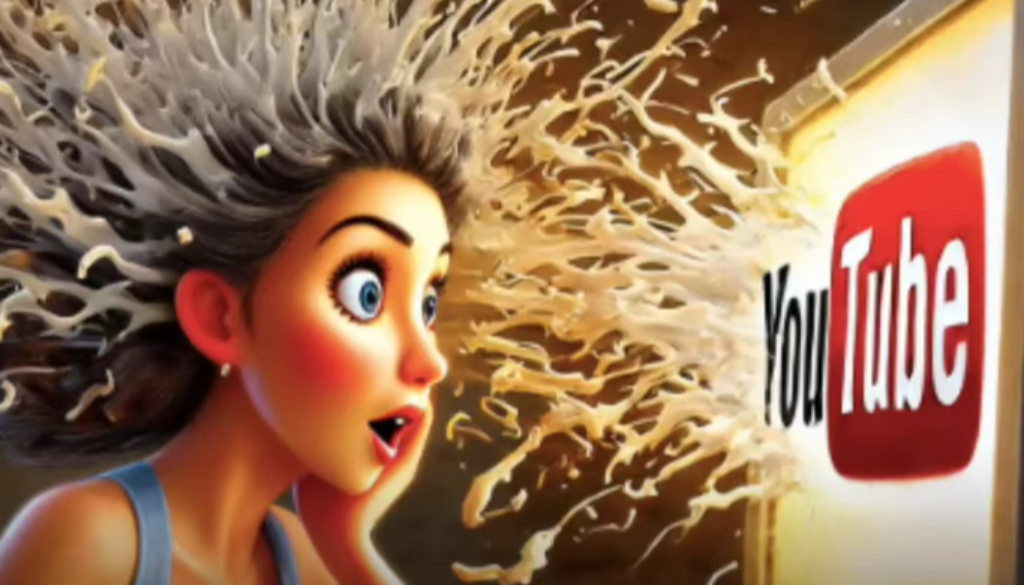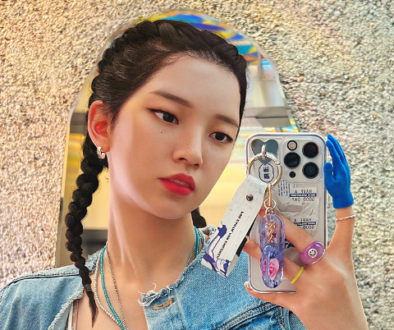The Rise of Virtual Influencers on YouTube: A Game Changer in Digital Content Creation
In recent years, YouTube has seen a transformative shift in the influencer landscape with the rise of virtual influencers. These digital personas, powered by advanced AI technology, sophisticated animation, and deep learning algorithms, have emerged as a significant force in content creation. Unlike human influencers, virtual influencers are entirely computer-generated, but their impact on YouTube and social media is undeniably real. As they gain popularity, virtual influencers are changing the game in the digital marketing world, redefining what it means to be a social media star.

In this comprehensive exploration, we’ll delve into how virtual influencers are revolutionizing YouTube, the technology behind their creation, their impact on brand partnerships, and the ethical considerations surrounding their rise. The emergence of virtual influencers marks a new era in digital content creation—one that blends creativity, technology, and a deep understanding of audience engagement.
Understanding Virtual Influencers: What Are They?
Virtual influencers are digital characters created using computer graphics, AI, and machine learning. Unlike traditional influencers, who are real people with real-life experiences, virtual influencers are fictional personas designed by creative teams. These digital beings are meticulously crafted to look, behave, and interact like humans, often blurring the lines between reality and fiction.
The creation of a virtual influencer involves a combination of digital artistry and AI. Graphic designers and animators build the visual aspects, while AI technology is used to simulate realistic interactions, speech patterns, and even personality traits. These influencers are typically managed by a team of content creators who script their interactions, develop their backstories, and strategically position them in the digital landscape.

Virtual influencers first gained traction on Instagram, where their perfectly curated feeds captivated audiences. However, it is on YouTube—a platform known for its dynamic and engaging content—where they are truly making their mark. With the ability to create a diverse range of content, from vlogs to music videos and even interactive live streams, virtual influencers are redefining content creation on the platform. Their presence is not just a novelty; it represents a significant evolution in how we consume and interact with digital content.
The Technology Behind Virtual Influencers
The rise of virtual influencers on YouTube is made possible by cutting-edge technology that combines AI, computer-generated imagery (CGI), and machine learning. Creating a virtual influencer involves several complex processes, from designing the character’s appearance to programming their interactions and behaviors.
At the core of virtual influencer technology is AI, which allows these digital personas to mimic human behavior. Natural language processing (NLP) enables them to engage in conversations, respond to comments, and even adapt their personalities based on audience interactions. Machine learning algorithms allow virtual influencers to improve and evolve over time, learning from their interactions to become more relatable and engaging.
Computer-generated imagery (CGI) is responsible for the lifelike appearance of virtual influencers. Advanced animation techniques give them realistic facial expressions, body movements, and even intricate details like hair and clothing. These visuals are often rendered in high definition, making virtual influencers indistinguishable from real humans in their video content.
The combination of AI and CGI enables virtual influencers to create content that is not only visually stunning but also deeply engaging. On YouTube, where content quality and viewer engagement are paramount, this technology allows virtual influencers to stand out, offering audiences a unique and immersive experience. As technology continues to advance, we can expect virtual influencers to become even more sophisticated, further blurring the lines between digital and physical reality.

The Appeal of Virtual Influencers on YouTube
One of the key reasons for the rapid rise of virtual influencers on YouTube is their broad appeal. Unlike human influencers, virtual influencers can be crafted to embody any personality, appearance, or background. This flexibility allows creators to design influencers that perfectly align with target audience preferences, making them highly relatable and engaging.
Virtual influencers also offer consistency, which is a significant advantage in the fast-paced world of digital content. They don’t age, experience burnout, or have off-days, ensuring a steady stream of content that keeps audiences engaged. For brands, this reliability translates into more consistent and predictable collaboration opportunities.
Moreover, virtual influencers have a distinct advantage in their ability to adapt to different roles and content types seamlessly. Whether it’s fashion, gaming, lifestyle, or even music, virtual influencers can effortlessly transition between genres, creating content that resonates with diverse audiences. Their versatility is a game changer, particularly in a platform like YouTube, where varied content types often attract larger and more engaged audiences.
Additionally, virtual influencers can exist in multiple places simultaneously, participating in events, live streams, and collaborations without the logistical challenges that human influencers face. This omnipresence makes them incredibly valuable in a digital landscape that increasingly demands constant engagement and visibility.
The Impact on Brand Partnerships and Marketing
The rise of virtual influencers on YouTube is transforming the way brands approach digital marketing. With their carefully crafted personas and highly engaged audiences, virtual influencers are becoming the go-to choice for brands looking to reach specific demographics.
One of the most significant advantages of working with virtual influencers is the level of control brands can exert over the influencer’s persona and content. Since virtual influencers are entirely created and managed by teams of professionals, brands can collaborate more closely in developing campaigns that align perfectly with their image and messaging. This level of precision is difficult to achieve with human influencers, who come with their own personalities, opinions, and potential unpredictability.
Moreover, virtual influencers are not bound by physical limitations, allowing them to participate in brand campaigns across various platforms and mediums. They can appear in multiple locations simultaneously, collaborate with other virtual or human influencers, and create content that integrates seamlessly with brand narratives. This flexibility is particularly valuable in global campaigns, where consistency and cohesion are crucial.
The authenticity of virtual influencers is another factor contributing to their appeal in brand partnerships. While these digital beings are not real, their interactions, stories, and content are meticulously designed to feel authentic. For many audiences, particularly younger viewers, this digital authenticity is just as compelling as the real thing. Brands can leverage this by creating narrative-driven campaigns that resonate on an emotional level with viewers, driving deeper engagement and brand loyalty.
Challenges and Ethical Considerations
The rise of virtual influencers on YouTube brings with it a host of challenges and ethical considerations that cannot be ignored. While these digital personas offer numerous advantages, they also raise important questions about authenticity, transparency, and the impact on human influencers and society at large.
One of the primary concerns is the issue of authenticity. Virtual influencers are, by design, fictional characters created to serve specific purposes, often commercial in nature. This raises questions about the transparency of their content—are viewers always aware that they are interacting with a digital persona rather than a real person? The potential for deception is a significant concern, particularly when virtual influencers are used to promote products or services.
Another ethical consideration is the impact of virtual influencers on the job market for human influencers. As brands increasingly turn to virtual influencers for their campaigns, there is a growing concern that human influencers, particularly those at the lower end of the market, may find themselves sidelined. This shift could have broader implications for the influencer economy, potentially reducing opportunities for real people to make a living through content creation.
The potential for exploitation is another issue that needs to be addressed. Since virtual influencers are created and controlled by companies, there is a risk that these digital personas could be used to manipulate audiences in ways that are not possible with human influencers. This could include promoting unhealthy lifestyles, spreading misinformation, or perpetuating harmful stereotypes.
Virtual Influencers vs. Human Influencers: A Comparative Analysis
The rise of virtual influencers on YouTube has sparked an ongoing debate about the future of human influencers and the potential for virtual influencers to replace them. While both types of influencers have their unique strengths and challenges, the comparison between the two offers valuable insights into the evolving landscape of digital content creation.
Human influencers bring a level of authenticity and relatability that virtual influencers cannot fully replicate. Real-life experiences, emotions, and interactions allow human influencers to connect with their audiences on a personal level. This connection is often the foundation of their influence, as viewers feel they are following a genuine person with whom they can relate. Human influencers also bring a diverse range of backgrounds, personalities, and perspectives, enriching the content ecosystem with varied voices and stories.
On the other hand, virtual influencers offer advantages in consistency, creativity, and control. Their digital nature allows for content that is visually stunning, flawlessly executed, and perfectly aligned with brand messaging. Virtual influencers can also explore creative concepts that may be difficult or impossible for human influencers to achieve, such as fantastical environments, impossible stunts, or interactions with other virtual characters.
The comparative analysis between virtual and human influencers highlights that each has its place in the digital landscape. Rather than replacing human influencers, virtual influencers are likely to complement them, offering brands and audiences a broader spectrum of content and engagement opportunities. The future of digital content creation will likely see a coexistence of both, with each type of influencer bringing unique value to the table.
Case Studies: Successful Virtual Influencers on YouTube
To understand the impact of virtual influencers on YouTube, it’s essential to look at specific examples of how these digital personas have achieved success. Several virtual influencers have not only gained massive followings but have also played a pivotal role in shaping the future of digital content.

Lil Miquela, often referred to as the original virtual influencer, has been a trailblazer since her debut. With millions of followers across social media platforms, including YouTube, Lil Miquela’s content blends fashion, music, and social commentary. Her collaborations with major brands like Prada and Calvin Klein have set the standard for virtual influencer marketing, demonstrating how digital personas can drive engagement and brand recognition.
Shudu Gram, the world’s first digital supermodel, has made waves in the fashion industry with her stunningly realistic appearances. Her YouTube channel features behind-the-scenes looks at fashion shoots, style tips, and collaborations with top fashion houses. Shudu’s success illustrates the potential for virtual influencers to dominate niches traditionally reserved for human influencers, such as high fashion and beauty.

Kizuna AI, one of the most popular virtual YouTubers, has been a game changer in the realm of gaming and entertainment. With her cheerful personality and interactive content, Kizuna AI has amassed millions of subscribers, setting the stage for the rise of virtual influencers in the gaming community. Her influence extends beyond YouTube, with appearances in virtual concerts, collaborations with other digital creators, and even her own merchandise line.
These case studies demonstrate the diverse ways in which virtual influencers can succeed on YouTube. Whether through fashion, music, gaming, or lifestyle content, these digital personas are proving that they are more than just a passing trend—they are a powerful force in the world of digital content creation.
The Future of Virtual Influencers on YouTube
As we look to the future, the role of virtual influencers on YouTube is likely to expand even further. Advances in AI and CGI technology will continue to enhance the realism and capabilities of these digital personas, making them even more engaging and interactive. The integration of virtual influencers into emerging technologies, such as virtual reality (VR) and augmented reality (AR), will open up new possibilities for immersive content experiences.
Virtual influencers are also expected to play a significant role in the development of the metaverse, a digital universe where people can interact in real-time through avatars. In this new digital frontier, virtual influencers could serve as guides, entertainers, and even friends to users navigating these virtual worlds. The metaverse will likely become a key platform for virtual influencers, offering them a space to interact with audiences in ways that are currently unimaginable on traditional social media platforms.
Furthermore, as virtual influencers continue to gain acceptance and popularity, we may see a shift in how they are perceived by audiences. The current debate over their authenticity and impact on human influencers may evolve as viewers become more accustomed to interacting with digital personas. Over time, virtual influencers may become a normalized part of the digital content ecosystem, valued for their unique contributions to entertainment and marketing.
The Impact on the Broader Social Media Landscape
The rise of virtual influencers on YouTube is not just a YouTube phenomenon—it’s part of a broader shift in the social media landscape. As these digital personas gain traction, their influence is spreading to other platforms, such as Instagram, TikTok, and even emerging social networks. This cross-platform presence allows virtual influencers to reach a wider audience and amplify their impact on digital culture.
![]()
Virtual influencers are also changing the way social media platforms are used by brands and marketers. Traditional influencer marketing strategies are being rethought to accommodate the unique characteristics of virtual influencers, such as their ability to create highly controlled and visually stunning content. This shift is leading to new forms of collaboration and content creation, where brands and virtual influencers work together to produce innovative campaigns that resonate with digital-native audiences.
Moreover, the success of virtual influencers is prompting social media platforms to invest more in AI and AR technologies, creating tools and features that enhance the capabilities of digital content creators. This investment is driving the evolution of social media into more immersive and interactive experiences, where users can engage with content in new and exciting ways.
The broader impact of virtual influencers on the social media landscape is profound, as they challenge the norms of what it means to be an influencer and push the boundaries of content creation. As they continue to rise, virtual influencers are poised to play a central role in shaping the future of social media.
Conclusion: Virtual Influencers as Game Changers
The rise of virtual influencers on YouTube marks a significant turning point in the world of digital content creation. These digital personas, powered by advanced AI and CGI technologies, are not only captivating audiences but are also redefining the relationship between creators, brands, and consumers.
Virtual influencers bring a unique blend of creativity, consistency, and control that is changing the way content is produced and consumed. Their ability to adapt to different roles, genres, and platforms makes them versatile and valuable assets in the digital marketing landscape. As they continue to evolve, virtual influencers are set to become even more integrated into the fabric of social media, offering new possibilities for engagement and interaction.
However, their rise also presents challenges and ethical questions that need to be carefully navigated. The impact on human influencers, the potential for exploitation, and the issues of authenticity and transparency are all critical considerations as we move forward into this new era of digital content.
In conclusion, virtual influencers are more than just a passing trend—they are game changers in the digital world. As they continue to rise on YouTube and beyond, they are reshaping the landscape of social media, offering a glimpse into the future of digital content creation. Whether they will complement or compete with human influencers remains to be seen, but one thing is certain: virtual influencers are here to stay, and their influence will only continue to grow.




